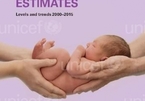 |
After the first six months, Hanoi's gender ratio at birth is 112.8 boys/100 girls, which is better than the target (113.5 boys/100 girls in 2018 and 114.5 boys/100 girls in 2017).
Ta Quang Huy, head of the Hanoi Department of Population and Family Planning, said that the city's success in reducing the gender imbalance at birth is thanks to many solutions applied in 30 districts and towns, such as reducing the third child birth, prohibiting gender selection for the fetus, upholding the role of women in family and society, praising couples who give birth to daughters, among others.
However, in some rural districts such as Soc Son, Quoc Oai, My Duc, the boy-to-girl ratio is still high. Soc Son district recorded the gender ratio at birth of 120 boys for every 100 girls, while the ratio in Quoc Oai and My Duc districts is 115/100.
According to the World Health Organization, natural “sex ratio at birth” is often considered to be around 105 or 105 males for every 100 females.
If the number of males exceeds 105, there will be serious social consequences in the long run.
According to General Office for Population and Family Planning (GOPFP) under the Ministry of Health, Vietnam’s gender imbalance tends to be worse.
In 2018, the sex ratio at birth was 115.1 boys/100 girls, representing an increase of 3% compared to 2017 and failing to reach the target of reducing the ratio to 112.8 boys/100 girls.
Vietnamese people traditionally favor boys over girls. Many believe that only sons could be responsible for worshiping their ancestors and maintaining the lineage.
This is the gender prejudice and the underlying cause for sex imbalance at birth, according to population experts.
Besides, since the introduction of ultrasound technology to identify the baby’s gender, the sex imbalance increases.
Many people are willing to abort when they know that the fetus is a girl.
Gender imbalance at birth will adversely affect population structure in the future, which leads to male surplus in society.
Without timely interventions, it is estimated that by 2050, from around two to 4.3 million men will remain without wives. In the long term, serious consequences such as a shortage of women will increase pressure on early marriage for girls or give way to prostitution and trafficking of women. Hanoitimes
Trung Kien

Vietnam has lowest low birth weight rate in Southeast Asia & Oceania
Number of low birth weight babies remained almost constant in Vietnam over last 15 years, according to latest figures.

Woman gives birth to triplet in one egg: rare in globe
A Vietnamese woman in the northern province of Tuyen Quang gave birth to triplet by C- section in one-hour.
 According to the Hanoi Department of Population and Family Planning, the city set the goal for 2019 of achieving the gender ratio at birth of 113 boys/100 girls.
According to the Hanoi Department of Population and Family Planning, the city set the goal for 2019 of achieving the gender ratio at birth of 113 boys/100 girls.